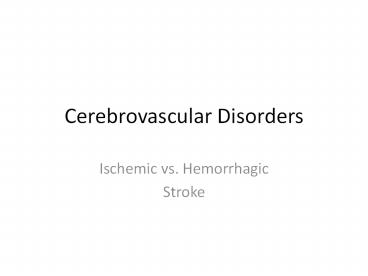Cerebrovascular Disorders - PowerPoint PPT Presentation
1 / 21
Title:
Cerebrovascular Disorders
Description:
Third most common cause of death in US. Primary cause of ... Gout. History: Cardiac enlargement. Hyperlipidemia. Lack of exercise. Hormonal contraceptive use ... – PowerPoint PPT presentation
Number of Views:266
Avg rating:3.0/5.0
Title: Cerebrovascular Disorders
1
Cerebrovascular Disorders
- Ischemic vs. Hemorrhagic
- Stroke
2
Stroke (Brain Attack)
- Sudden disruption in the normal blood supply to
the brain - fka Cerebrovascular Accident (CVA)
- Medical emergency
- Immediate treatment required
- Third most common cause of death in US
- Primary cause of adult disability
- Why is disrupted blood supply a concern?
- What are the Implications?
3
Stroke Risk Factors
- History
- TIA
- ASCVD
- HTN
- Dysrhythmia (Atrial Fib)
- ECG changes
- Rheumatic heart disease
- Diabetes Mellitus
- Gout
- History
- Cardiac enlargement
- Hyperlipidemia
- Lack of exercise
- Hormonal contraceptive use
- Drug abuse
- Smoking
- Family history of stroke
- Sickle cell disease
4
Classifications
- Transient Ischemic Attack (TIA)
- Least severe
- Temporary
- Complete return to normal functioning
- Progressive
- Begins with slight neurologic deficit and worsens
over a day or two - Complete
- Most severe
- Causes maximum neurologic deficits at onset
5
TIA
- To remember important points of TIA
- T Transient episode that clears in 12-24 hrs
- I Warning sign of Impending stroke
- A Aspirin and Anticoagulants to minimize risk of
thrombosis
6
Types of Strokes
- Compare and contrast the two types of strokes
- Identify the three major causes of stroke in
order of incidence
- Ischemic
- Caused by occlusion of a cerebral artery
- Hemorrhagic
- Ruptured sacular aneurysm
- Ruptured atreriovenous malformation (AVM)
- Hypertension
7
Pathophysiology Of Ischemic Stroke
- Create a flow-chart concept map of the
Pathophysiology of an Ischemic Stroke.
8
Pathophysiology of Hemorrhagic Stroke
- What do you need to know to be able to discuss
the pathophysiology of a Hemorrhagic Stroke?
9
Stroke Assessments
- Accurate History
- Activity when stroke began
- Ischemic sleep
- Hemorrhagic activity
- Progression of Sx
- Objective assessment
- Loss of consciousness, dizziness, seizure
- Level of Consciousness
- Current LOC
- Presence of deficits
- Medical History
- Head trauma
- HTN
- Heart disease
- Anemia
- Obesity
- Headache
- Current meds
- Anticoagulants
- ASA
- Vasodilators
- Illegal drugs
10
Assessment
- What will physical findings depend upon?
- How will data be gathered if patient is unable
to give history information?
11
Diagnostics
- Noncontrast CT
- 12 Lead ECG
- Carotid ultrasound
- Cerebral angiography
- Trancranial doppler studies
- Transthoracic or transesophageal echo
- MRI
- Xenon enhanced CT
- SPECT
- Which of these are considered the standard
diagnostics? - Why should contrast not be used for the CT?
- What is the role of the nurse in these
diagnostics?
12
Collaborative Problems/Potential Problems
- Ischemic
- ?cerebral blood flow due to ? ICP
- Inadequate oxygen to the brain
- Pneumonia
- Hemorrhagic
- Vasospasms
- Seizures
- Hydrocephalus
- Rebleeding
- Hyponatremia
13
Ischemic Stroke Medical Management
- Secondary prevention
- Thrombolytic therapy
- Maintenance of cerebral perfusion
- Managing potential complications
- Surgical prevention
- What measures will be included for these
interventions?
14
Ischemic Stroke Nursing Interventions (Recovery)
- Improve mobility and prevent joint deformity
- Prevent shoulder pain
- Enhance self-care
- Manage sensory-perceptual difficulties
- Assist with nutrition
- Attaining bowel and bladder control
- Improving thought processes
- Improving communication
- Maintaining skin integrity
- Improving family coping
- Helping patient cope with sexual dysfunction
15
Hemorrhagic Stroke Nursing Interventions
- Optimizing cerebral tissue perfusion
- Relieving sensory deprivation and anxiety
- Monitoring and managing potential complications
16
Stroke Impaired Verbal Communication
- Occurs in dominant hemisphere/majority in left
hemisphere - Dysarthria due to loss of motor function
- Aphasia caused by cerebral hemisphere damage
- Expressive (Brocas or motor) aphasia
- Receptive (Wernickes or sensory) aphasia
- Discuss how impaired verbal communication
impacts the patient/client, the family and the
caregiver.
17
Impaired Communication
- Compare and Contrast the different types of
aphasia. - How would your plan of care differ in regards to
the type of aphasia experienced?
18
Left Frontal Stroke
19
Left Frontal Stroke (underside)
20
Right Sided Stroke
21
Right Sided Stroke































